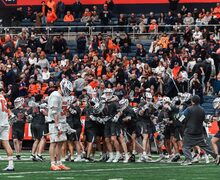What we learned from Syracuse basketball’s loss to Georgetown
Logan Reidsma | Photo Editor
Dajuan Coleman showed on Saturday that his offensive game is progressing as he is still working back from missing nearly two full seasons due to injury.
WASHINGTON, D.C. — Syracuse lost its second straight game on Saturday, this one to Georgetown, 79-72, at the Verizon Center.
The Orange (6-2) fell behind by 12 at halftime and by as many as 21 in the second half, and didn’t rebound or shoot well enough to fully compete with the well-rounded Hoyas (4-3). Here are three things we learned about Syracuse from the game, which was the first without Jim Boeheim as he serves his nine-game suspension from the NCAA.
1. Dajuan Coleman is making strides on offense
The junior center tied a season-high with 21 minutes, and scored in double-figures for the first time of the young season. The Hoyas still outrebounded the Orange and Georgetown center Bradley Hayes finished with 21 points and eight rebounds, but Coleman’s contributions were a bright spot of Syracuse’s anemic offensive performance.
“I felt good,” Coleman, who began the season coming off a 22-month rehab from back-to-back knee injuries, said. He added that he is feeling more comfortable with each passing game.
Coleman’s five rebounds were on the offensive end, and he said he has to improve his defensive rebounding moving forward. Either way, his activity on offense was a welcome sign for an offense that can’t afford to have a completely unproductive post player.
This season, Syracuse has mostly played a four-around-one with 6-foot-8 freshman Tyler Lydon stretching the floor from the perimeter. That leaves either Coleman or forward Tyler Roberson in the offensive “center spot,” which mostly includes setting on-ball screens and rolling toward the rim. With Roberson in the game, defenses have to respect him and can’t hedge as hard on screens, which closes driving lanes for the Orange guards.
And when Roberson got in early foul trouble, the Hoyas started hedging harder because Coleman didn’t provide as much of an offensive threat. But when Coleman got going in the second half — which is when he scored eight of his 10 points — Georgetown hedged less and there were more driving opportunities for his teammate.
2. This team, more than ones of the recent past, can’t afford to let the ball into the high post
Georgetown used quick perimeter passes to stretch out Syracuse’s 2-3 zone, and then went through the high post to exploit the Orange inside.
The SU zone makes it hard to enter the ball into the post from the perimeter, but getting the ball into the high post leads to easy access to the paint. The Hoyas worked the ball into that spot with ease, whether it was to stretch forward Marcus Derrickson or athletic forward Isaac Copeland.
And Saturday proved that this Syracuse team really can’t afford to let the ball into the high post. In past years, centers like Rakeem Christmas, Baye Moussa Keita and Fab Melo were reliable rim protectors. But Coleman, Lydon and Roberson don’t have the same defensive presence around the rim, and that showed with how the Hoyas dominated inside.
“We had to take away the high-post pass,” Coleman said of how the team could have defended Hayes better. “Every time they got in the high post they could have made shots. We had to play them in between and get them off the block.”
Defending the high post is ultimately the guards’ responsibility in the 2-3 zone, and Trevor Cooney wasn’t happy with how he and the backcourt did in that regard.
“Teams are going to get it in the high post, we can take it away but then there are other things they could do,” Cooney said. “We just have to move better when they get in the high post and kick out and get out to shooters, and defend better and move better.”
3. Freshman Frank Howard is gaining the coaches’ trust
Howard saw extended, meaningful minutes for the first time this season and helped the Orange by getting to the rim.
While Howard didn’t put up eye-popping stats — he finished with four points on 2-of-8 shooting and dished out two assists in 13 minutes — interim head coach Mike Hopkins turned to him when Syracuse needed a comeback in the second half. Playing in place of freshman Malachi Richardson and alongside Cooney and Michael Gbinije, Howard got into the cracks of Georgetown’s high-pressure man-to-man defense and opened opportunities for his teammates.
On the defensive end, the 6-foot-4 guard used his length to clog passing lanes and deflect passes.
After the game, he said Boeheim had told Hopkins he was playing well after a handful of “good practices” this week.
“I think sometimes the defense can collapse on those two because they’re such great scorers,” Howard said of creating for Cooney and Gbinije. “Now when I have the ball I can make a read off them and they can come off screens, and have a little bit more opportunity. I don’t think a team can collapse on them as much, and that’s what I try to bring to the table.”
Hopkins didn’t say that Howard had supplanted sophomore Kaleb Joseph as the first off-the-bench guard, but that it was a situational decision to play the freshman down the stretch. Joseph played three first-half minutes and didn’t record a stat.
Published on December 5, 2015 at 6:58 pm





